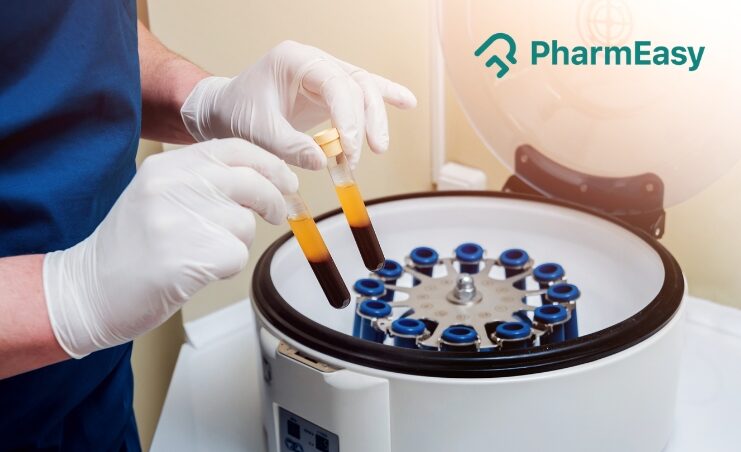Causes of Low Platelet Count & Tips for Improving Them
By Dr. Nayana Shetty +2 more

Get,

to manage your symptom
Get your,


4 Cr+ families
benefitted

OTP sent to 9988776655



You’ve successfully subscribed to receive
doctor-approved tips on
Whatsapp

Get ready to feel your best.

Hi There,
Download the PharmEasy App now!!


Register to Avail the Offer
Send OTPBy continuing, you agree with our Privacy Policy and Terms and Conditions

Hi There,
Sign up on PharmEasy now!!
Trusted by 4 crore+ families

OTP sent to 9988776655



You have unlocked 25% off on medicines




Code: NU25
By Dr. Nayana Shetty +2 more
Table of Contents
Platelets play a crucial role in blood clotting, and having inadequate platelet counts can lead to issues like difficulty in stopping bleeding1. Low platelet count, also known as thrombocytopenia, can occur due to many factors. In this article, we will delve into the production, functions, and health issues associated with platelets; what triggers a low platelet count; and how it’s diagnosed. We will also discuss management options for thrombocytopenia, including simple lifestyle changes.
A low platelet count is defined as less than 150,000 platelets per microliter in the bloodstream2.

Platelets play an essential role in stopping bleeding by helping the blood form clots. When a blood vessel is injured, platelets quickly gather at the site and stick together to form a plug, avoiding further blood loss.
Normal platelet count ranges between 150,000 and 450,000 platelets per microliter of blood1.
This section outlines common signs that may appear when a person has a low platelet count.
Timely medical intervention is key in thrombocytopenia management4.
To my knowledge, severe internal bleeding may be more likely to occur in those with severe thrombocytopenia (or low platelet count). Bleeding in the brain or gastrointestinal tract might result from thrombocytopenia. Bleeding in the brain is a potentially fatal condition3.
Dr. Siddharth Gupta, B.A.M.S, M.D
A low platelet count can occur due to various factors. These may include:
An enlarged spleen, a condition called splenomegaly, can trap too many platelets. This reduces the number circulating in the bloodstream5.
The bone marrow produces platelets. Any condition that affects the marrow can lower platelet levels. These conditions include:
In some cases, the body destroys platelets faster than they are made. This may occur due to:
Diagnosing thrombocytopenia usually involves a combination of clinical assessment and laboratory tests. These may include:
Your doctor will examine your skin for signs of unusual bleeding, such as bruising or petechiae. They may also check your abdomen for an enlarged spleen.
You will be asked about any previous illnesses, ongoing health conditions, or medications that could affect platelet levels.
A CBC test is used to measure the number of platelets and other blood cells. This is usually the first step in identifying thrombocytopenia6.
If an enlarged spleen is suspected, an abdominal ultrasound may be recommended. This helps your doctor assess the size and condition of the spleen5.
To better understand the cause of low platelet production, your doctor may collect a small sample of bone marrow fluid (aspiration) or tissue (biopsy). This test provides detailed information about how blood cells are being produced in your body7.
Due to its antioxidant qualities, dragon fruit might help people with dengue increase their platelet counts. For this reason, doctors may advise dengue patients to eat dragon fruit. However, there is lack of enough large scale studies to back this up11.
Dr. Smita barode, B.A.M.S, M.S.
Managing thrombocytopenia involves treating the underlying cause while also addressing the symptoms. Here are some common treatment approaches used to manage low platelet count, depending on the underlying cause:
If low platelet counts have been caused by medications, your doctor may adjust the medicine dose or switch to an alternative medicine1.
When infections such as viral illnesses are the cause, managing the infection may help restore platelet levels.
If your immune system is mistakenly destroying platelets (as seen in conditions like ITP), your doctor may prescribe medicines to suppress this immune response and support platelet recovery3.
In cases of very low platelet count or severe bleeding, blood transfusions may be required to replace lost blood components, such as red blood cells or platelets3.
Platelet transfusions may be needed when platelet counts are dangerously low or if there is active bleeding. Platelet transfusions may help improve blood clotting temporarily1.
Certain medicines, such as prednisone (a steroid), avatrombopag, romiplostim, and eltrombopag, may be prescribed to stimulate the body to produce more platelets. In individuals with immune-related thrombocytopenia, medicines like rituximab and immunoglobulins may be used to stop the destruction of platelets by the immune system1,3.
In individuals with chronic or severe thrombocytopenia, such as ITP, removing the spleen surgically (splenectomy) may be recommended when other treatments are ineffective. Splenectomy can help increase platelet counts by reducing the destruction of platelets.
Adopting simple lifestyle changes along with medical treatment may help support overall health and reduce risks related to a low platelet count.
Your doctor might advise against flossing until your platelet counts stabilise. You are advised to rinse and wash your teeth after every meal. To avoid bleeding gums, use an extra-soft toothbrush. Use hot water to make your toothbrush softer before each usage. Use extreme caution and gentleness when flossing. Steer clear of readily bled areas. Apply petroleum jelly or lip balm to keep lips hydrated and stop them from breaking. Consult your medical team before receiving any dental care10.
Dr. Rajeev Singh, BAMS
If left untreated, a low platelet count can lead to serious complications, some of which may be life-threatening.
Early detection of thrombocytopenia through routine checks and regular monitoring can help avoid complications and guide timely treatment.
Also Read: Low Platelet Count – Symptoms, Causes & Treatment
Maintaining a healthy platelet count is essential for avoiding excessive bleeding and supporting your body’s natural healing processes. Early recognition of symptoms like easy bruising, petechiae or prolonged bleeding and getting promptly evaluated can help identify the underlying cause and guide appropriate treatment. By combining professional care with simple lifestyle measures, most people with thrombocytopenia can effectively manage their condition and reduce the risk of complications.
Managing a low platelet count depends on its underlying cause. Treatment may involve adjusting medications, addressing infections, or treating immune system conditions. Always speak to your healthcare provider for appropriate guidance.
There is no single common cause of thrombocytopenia. Low platelet count can result from an enlarged spleen, bone marrow disorders, infections, or inherited conditions.
A mildly low count without symptoms may not be a cause for concern. However, if your count is very low or you have symptoms like bruising or bleeding, seek medical advice promptly.
Yes, a platelet count of 81,000 platelets per microlitre is considered low. The normal range is 150,000 to 450,000. If your platelet count is below normal, consult your doctor for evaluation and further testing.
Foods rich in vitamin K, vitamin B-12, iron, and folate may help boost platelet counts. However, speak with your healthcare provider before making dietary changes, especially if your platelet count is low.
Disclaimer: The information provided here is for educational/awareness purposes only and is not intended to be a substitute for medical treatment by a healthcare professional and should not be relied upon to diagnose or treat any medical condition. The reader should consult a registered medical practitioner to determine the appropriateness of the information and before consuming any medication. PharmEasy does not provide any guarantee or warranty (express or implied) regarding the accuracy, adequacy, completeness, legality, reliability or usefulness of the information; and disclaims any liability arising thereof.
Comments

Leave your comment...
You may also like
Comments